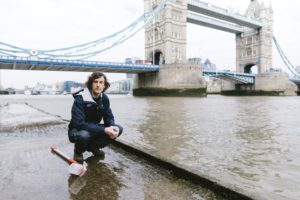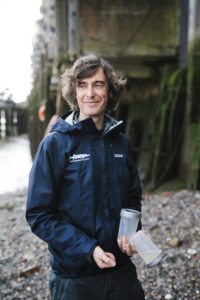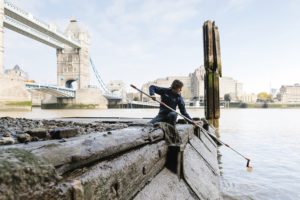Thames Tamer | Theo Thomas, London Waterkeeper
By: ajcarapella
London Waterkeeper Theo Thomas is battling to transform London’s iconic waterway into a river fit to swim.

By Lisa W. Foderaro.
Photos by ©Finn Beales, courtesy of Culture Trip.
Few rivers have had as long and illustrious a history as the Thames. It was where Julius Caesar led an invasion in 54 B.C., finding a fortified line of British tribes along the northern bank; where, a thousand years later, the Danish King Cnut established his rule over England; and where, in the 1500s, Queen Elizabeth I paraded amid a royal flotilla.
But as much as its history is tied to war and royalty, and later industry and commerce, the River Thames also bears a more prosaic distinction — as one of the oldest sewers on the planet. There is evidence of wooden sewer pipes dating to Roman times, and for centuries the dumping of waste continued, along with garbage, animal carcasses and eventually industrial chemicals. By the 1800s, the stench was so bad that the windows of Parliament were hung with chlorine-soaked curtains — but to no avail. Benjamin Disraeli, then Chancellor of the Exchequer, bemoaned that the Thames was a “Stygian pool reeking with ineffable and unbearable horror.”
Today, things are considerably better, thanks to the decline of manufacturing in London and its environs, modern sewage treatment, and new environmental laws. Ferries and excursion boats now ply the choppy waters in the heart of London, and kayaks are a common sight. Porpoises and seals have returned. But the Thames is far from pristine. Raw sewage flows into the river between 30 and 50 times a year, the result of so-called combined sewer overflows. That is the term for sewage discharges that occur when waste-treatment plants that handle both stormwater and wastewater are overwhelmed by rain, sending the whole mess into the river untreated.
So when Theo Thomas, the London Waterkeeper, goes for a swim in the Thames in London, where he lives, it is as much to make a political statement as it is for pleasure.
“The pollution has no right to be in the river; we do,” he says. “Our defense of the environment has to be stated quite viscerally – putting our bodies in it and for it. Throughout history, that’s the only way things have been changed. With the civil rights movement and with votes for women, people put their bodies in the way of the problem.”
Theo usually waits five days after it rains to dive into the river, in a section of London called Richmond upon Thames, which has riverfront parks and where tides are relatively weak. That, he says, is when the river returns to bathing-water quality. In his professional life, however, he is decidedly less patient, even as the private company that oversees sewage treatment, Thames Water, builds a $4.2 billion “super sewer” that will stanch most sewage overflows by storing the wastewater until treatment plants can accept it.
“Our defense of the environment has to be stated quite viscerally – putting our bodies in it and for it. Throughout history, that’s the only way things have been changed. With the civil rights movement and with votes for women, people put their bodies in the way of the problem.”
When the 15-mile “Tideway Tunnel” is completed in 2023, such overflows are expected to occur only four times a year, a decrease that should transform water quality in the Thames. But Theo wants assurances that the water company will closely monitor overflows after the tunnel’s completion, so that residents will know whether or not the discharges are actually that rare, and whether or not they got their money’s worth. After all, utility customers are footing the bill for the super sewer through rate increases.
In the meantime, Theo believes, people should have real-time information online about current sewage overflows along the entire Thames, which winds for 215 miles from Gloucestershire to the North Sea. Such an alert system is now in place in Copenhagen, and has led to increased water recreation there. Since becoming London Waterkeeper in 2014, Theo has promoted the notion of a swimmable Thames — “A Thames Fit to Swim” is his mantra — and badgered Thames Water to develop a system similar to Copenhagen’s.
Indeed, under British law the water company is required to make such information public. But first, Theo says, Thames Water must establish monitoring at its outfall pipes — where combined overflows are discharged — so that it has the necessary data.
“I did one information request,” he recalls, “asking how many combined sewers they have and how often they overflow between Richmond and Putney, a stretch of about 10 miles. And they said, ‘We’ve got 35, but we only know when 12 of them overflow, and we have no idea how much comes out of them.’ In a lot of cases, they don’t have any information to put in the public domain.”
Theo, 49, has an earnest gaze beneath a mop of chestnut hair, with a face that quickly morphs from serious to mischievous. He grew up in Knighton, a town of 3,000 on the border of England and Wales. His love of waterways stems from his childhood by the unspoiled River Teme.
“You would just go down to the river and spend time splashing around in it,” he recalls. “My friends and I would walk along the banks and follow the river out of town and into the hills. That was our landscape.”
“I’d seen how there were many people who wanted to make a difference at the grassroots, neighborhood level, but were often thwarted because they weren’t being listened to. I think public power is key to a cohesive society, and I felt I had a good understanding of how to help with that.”
He left Knighton to study at Warwick University near Birmingham. He majored in political science and got involved in student activism. He was mainly focused on the anti-apartheid movement, pressuring companies and campuses to divest from South Africa. The success of those protests made a lasting impression on Theo.
 “When Nelson Mandela was released from prison and the Berlin Wall fell — those things came about through people power,” he says.
“When Nelson Mandela was released from prison and the Berlin Wall fell — those things came about through people power,” he says.
After graduating, Theo took a job as a journalist with BBC Radio in Leicester. From 1995 to 2000, he covered stories on topics ranging from politics to crime to real-estate development. “Being a journalist,” he says, “was a great way of understanding how British society worked. You’d get access to all of the protagonists involved in different issues.”
In those years, Theo was what he calls a “lifestyle environmentalist” – buying organic vegetables, recycling and biking to work. But it didn’t feel like enough: “I’d seen how there were many people who wanted to make a difference at the grassroots, neighborhood level, but were often thwarted because they weren’t being listened to. I think public power is key to a cohesive society, and I felt I had a good understanding of how to help with that.”
He decided to return to his activist days, but there were very few environmental jobs in the East Midlands. Theo finally found a job as a press officer for an environmental organization in London, and when a position opened up at Thames21, a nonprofit group dedicated to cleaning up London’s rivers and canals, he moved there. He ran cleanups, supervised the removal of graffiti, and created a volunteer network.
Theo’s portfolio included the network of canals, which were mostly desolate backwaters rife with crime. “There were lots of people who lived close to the canals, but they were afraid to go near them because of drug activity,” he says. “They were quite sketchy places.” (Their banks have since been overdeveloped, he says, with upscale high-rises and pricey shops.)
Eventually, Theo saw the need to create an independent environmental group that didn’t rely on funding from Thames Water or the British government, as do many nonprofits, including Thames21. He also envisioned a group rooted in international environmentalism because he believed that was the only way to bring sufficient pressure on multinational corporations and governments that were among the world’s worst polluters.
“I had attended several of Waterkeeper Alliance’s international conferences and become friends with several Waterkeepers from different parts of the world,” he says. “I felt being a member of the Alliance would not only make me a more effective advocate in the UK but also allow me to work with other activists on a global level.”
As the London Waterkeeper, Theo prefers cooperation to litigation. “What’s important is social cohesion, finding a way to solve problems without falling into extreme conflict,” he explains.
Yet, while he might wield a carrot more often than a stick, the stick is never far from sight. With Thames Water, for example, he is willing to allow the company a generous time frame to develop a mechanism for detecting and publicizing sewer overflows. It’s a process that took Copenhagen more than 10 years to complete, he acknowledges. Still, he is quick to spell out the consequences of needless delay.
“Right now, we are walking arm in arm toward a door marked ‘Sewer Overflow Notifications,’” he says. “It’s brightly lit with rainbows over it. But right next to that door is one marked ‘Court Action and Prosecution.’ If at any point they deviate from fulfilling their legal duties, we can step through the other door and we will see them in court.”
Striking that balance between cooperation and antagonism is one reason Theo has proved such a powerful advocate for the Thames. Dee O’Connell, chairwoman of London Waterkeeper’s board, points to a few of the other qualities that make him a strong advocate: passion, fearlessness and a scientific mind. She reached out to Theo several years ago after a massive fish kill on the River Lea, a tributary of the Thames that her house in East London faces. He was still working for Thames21 at the time, and he trained her as a “citizen scientist” so that she could collect water samples.
“I was despondent because it didn’t seem like anyone was doing anything or really cared,” recalls Dee, who with her husband owns two outdoor apparel shops, called the Brokedown Palace, in London. “But Theo wanted to create proper change and get to the root cause of the pollution. He was willing to speak out about it. That was really inspiring.”
She followed him to London Waterkeeper, where she volunteered along with hundreds of others to send letters to Thames Water demanding information about combined sewer overflows. Since moving to the River Lea area 12 years ago, she has noticed a dramatic increase in the number of people using the water for recreation, including kayakers and paddle-boarders. As a result, she believes, people will pay attention to real-time alerts when they become available.
“I think his approach is clever because he is asking for something that’s achievable — information,” Dee says. “And it’s a long-term approach. When that information is public, people will be really shocked and they will put more pressure on Thames Water.”
Theo’s resolve to make Thames Water broadcast its overflows was strengthened during a vacation in Copenhagen with his wife and two young sons last year. He considered taking them swimming in the city center. “But,” he recalls, “I thought, ‘Hmm, it rained yesterday.’ I went online and saw that there was a red flag because sewers overflowed there. But 20 minutes out of town, it was green. That information meant we didn’t swim in sewage. We didn’t become ill. We had a wonderful day in the glorious sunshine, sitting on the beach looking out at the Baltic Sea. That was our memory of the holiday.”
“I had attended several of Waterkeeper Alliance’s international conferences and become friends with several Waterkeepers from different parts of the world. I felt being a member of the Alliance would not only make me a more effective advocate in the UK but also allow me to work with other activists on a global level.”
To pressure Thames Water to do the same as the Danish capital, in 2017 Theo enlisted hundreds of volunteers like Dee O’Connell to file requests for information about sewer overflows. Under British regulations that govern environmental information, if someone sends a letter or email asking about water quality, Thames Water has 20 days to respond. “That’s a very old-fashioned way of doing it,” he says.
Nonetheless, some 900 people sent requests to Thames Water about overflows. “Each one of these requests was legally binding, so they had to respond,” Theo explains. “We basically broke their system. Within three months, they contacted me and said: ‘We can’t cope. Please stop. Let’s meet.’”
The water company agreed to work toward posting current information on its website, starting with a pilot project near Henley-on-Thames, about an hour west of London.
“The idea is to develop a system that will generate real-time information and then replicate it,” Theo says. “Loads of people already swim in Henley-on-Thames, so it’s a good place to test out the system.”
Theo is passionate about using existing environmental laws. He points to the additional water-quality rules that Britain was subject to after joining the European Union in the 1970s. As a result, the British government was found guilty in 2012 of violating the Urban Waste Water Treatment Directive.

Threatened with accumulating daily fines, the government agreed to upgrade five sewage plants in central London. That work was completed in 2016, and the following year, there were news reports of at least three sightings of harbor porpoises in the Thames. In January 2019, one was caught on video swimming in the river in front of the Houses of Parliament.
But certainly Theo would like to see new environmental laws in Britain, specifically to control highway runoff — a toxic stew of heavy metals that often ends up in rivers. A number of techniques are available to filter or divert runoff, but they are seldom used.
“There is no law or rule that says when a road is upgraded that this type of drainage must be installed,” he laments. “So lots of opportunities are being missed.”
Another problem is runoff from industrial sites, especially along tributaries of the Thames like the Lea. Industrial discharges are strictly regulated (if not always enforced), but not so factory properties, where drums of chemicals are sometimes stored.
“There’s no monitoring of anything getting washed off their premises,” he says. “It’s a loophole. If the company is storing something that’s leaking, that’s a significant amount of stuff getting into the water. It could be worse than anything coming out of a pipe.”
Standing on the north bank of the Thames near St. Paul’s Cathedral on a hazy afternoon, Theo bends over to pick up vestiges of refuse deposited over centuries: fragments of clay tobacco pipes; roof tiles predating the Great Fire of London, and all manner of animal bones discarded by long-shuttered slaughterhouses. The occasional oyster shell hints at a distant past and a brighter future. Nearby, embedded in the 20-foot-high bulkhead, is a giant outfall pipe where sewage spills into the Thames when it rains. But, out on the river, next to Blackfriars Bridge, you can see a construction platform built in preparation for the super sewer expected to dramatically reduce the overflows.
“This is what investment in infrastructure looks like, but only because of environmental laws,” he says, looking toward the platform. “Without environmental laws, substantial environmental improvements are a pipe dream.”
Lisa W. Foderaro was a staff reporter for The New York Times for more than 30 years and has also written for National Geographic, Audubon Magazine, and Adirondack Life.